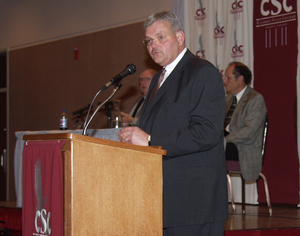CSC launches new school year

The introduction of 15 new professional staff members opened the new school year at Chadron State College Friday morning. Photos of several others who have accepted new responsibilities also were shown on a large screen in the Student Center.
After that, the college employees were urged to become involved in Vision 2011, Chadron State’s new strategic plan, and learned that Chadron State will soon begin a self-study that will be vital to attaining re-accreditation from the Higher Learning Commission in 2006.
College President Tom Krepel said it is a relief to be launching the new school year without the specter of more budget cuts. But he but added that he doesn’t expect the Legislature to provide much money for new programs during the 2005 session.
He added that he feels fortunate that Chadron State was able to retain “a full academic portfolio” while the numerous similar institutions can no longer say that following fiscal stress that swept across the country the past few years.
Also during his presentation, Krepel gave several statistics concerning the CSC student body. He said 58 percent of the students are the first members of their family to attend college, that 70 percent of them come from Nebraska and 91 percent of them are white. Fifty-eight percent are females. Krepel also reported that the student body’s average ACT score is 21.5 while the national average is 20.9. More than 30 high school valedictorians and salutatorians are included in the freshman class.
Fifty-three percent of the Nebraskans in the student body come from five counties—Box Butte, Dawes, Lincoln, Scotts Bluff and Sheridan.
It was announced during the meeting that the college’s administration has set aside $200,000 for implementation of the 84 activities that make up Vision 2011. Dr. George Watson, chairman of the committee that developed the new plan, urged all CSC employees to become involved in the implementation process.
“If we work hard to put these proposals into practice, we can be more than we are,” Watson stated. “We can be more innovative and more effective.”
Watson added that his committee will accept more activity proposals. “We want all the good ideas possible,” he said.
Dr. Richard Gowan, president emeritus of South Dakota School of Mines and Technology in Rapid City, spoke to the college staff about the re-accreditation process and its importance. He recently headed the re-accreditation teams that investigated two huge proprietary. for-profit institutions, the University of Phoenix and DeVry Institute.
Gowan said higher education is being challenged to provide data that it gives a good return on the investment being made by taxpayers and students. A strong self-study can supply the necessary proof, he said. He also pointed out that without accreditation a college is “out of business” because its students cannot receive federal financial aid.
The speaker said the accreditation process has become much more personalized in recent years. It now stresses that “no student be left behind,” and asks if the institution is doing everything possible to help each student succeed.
Some of the criteria, Gowan said, will include how the college is allocating its resources to prepare students for the future, evidence that the college values effective teaching and learning and the methods used for acquisition, discovery and application of knowledge.
Gowan, who was recently presented the highest award given by the National Society of Professional Engineers, said the re-accreditation process fits nicely with Vision 2001. “Both will allow you to examine what you are and where you want to go,” he said.
CSC President-emeritus Sam Rankin, now a board of trustees professor of history, and Dr. William Roweton, director of institutional research and assistant to the president, will head the re-accreditation efforts.
At the end of his talk, Gowan invited Chadron State to become a partner in the creation of the Homestake Deep Underground Science and Engineering Laboratory that is proposed for the former Homestake gold mine at Lead, S.D. There was no immediate reaction to the invitation from CSC officials, but they will have ample time to think about it. The National Science Foundation’s decision whether to accept the mine as the site for the national laboratory is not expected until fiscal 2008.
The national laboratory could mean hundreds of jobs for scientists, technicians and support personnel and exceptional educational opportunities for students.
Classes at CSC began Monday morning.
Category: Campus Announcements, Campus News
